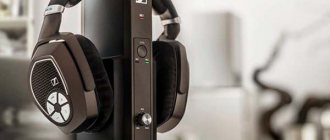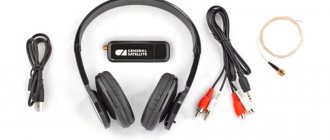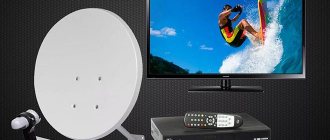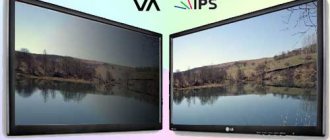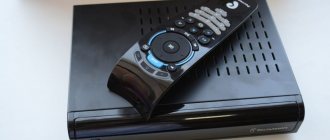Greetings! One of the favorite questions in our comments, chats and emails is “Recommend any headphones for TV.” With this approach it is very difficult to really advise anything. All markers have different tastes and colors, and specific models are not always found. In this article I would like to talk about Bluetooth headphones for Samsung TV. But the main thing is that there will be good advice on choosing the right ears so that everything works.
Have a question about a specific model? Write in the comments. Let's try to figure out the compatibility of the models together.
What headphones are suitable?
At the beginning I will give the basic compatibility algorithm, and then there will be specific tips.
- Do you have a Smart TV of the new series from H, J, M and onwards and has a Bluetooth module on board? Almost every first pair of headphones will do. Before purchasing, ask about compatibility, and if something happens, you can exchange them back while maintaining their presentation.
- There is no Bluetooth, but there is a 3.5 mm audio output on the TV? Consider a separate transmitter option.
- Is everything really bad? Or maybe it’s worth getting a separate TV set-top box? Otherwise, only replacing the TV will help.
One of the common detection problems is that the headphones must be charged. And feel free to turn them off and restart the TV. The pairing process does not always go smoothly.
Another tip - some transmitters are compatible only with their own manufacturer. Please check this point when purchasing. But in general, Bluetooth technology almost always works the same way—almost everything connects.
How to connect Bluetooth headphones to LG TV
It's a pity that I don't have an LG TV on webOS to check everything myself. There is not much information on this topic on the Internet. But as far as I understand, LG’s connection to Bluetooth devices is even more complicated. Only original devices can be connected. That is, original LG headphones, soundbar, etc. This can be done in the settings, in the “Sound” section – “LG sound sync (wireless)”.
And even if your TV model has built-in Bluetooth, it is used primarily to connect the LG Magic Remote and other branded devices.
You can also try connecting your headset using this scheme:
These are instructions from the official website. But as far as I understand, only branded headsets are connected this way.
Connecting Bluetooth devices via the LG TV Plus app
There is an app for Android and iOS called LG TV Plus. It is designed to control LG TVs that run webOS.
It seems like this application has something to do with it, right? But I found a video that shows how you can connect almost any Bluetooth device to an LG TV via LG TV Plus. Including headphones and speaker. I just can’t say for sure which version of webOS has this option. It looks like it's from webOS 3.0.
How it works: install LG TV Plus on a smartphone or tablet. Go to the application and connect to your TV. In the application settings there is a section “Bluetooth Agent”. Through this agent you can connect wireless headphones to your LG TV.
Here is the video (about the Bluetooth Agent function from 3:48):
Many thanks to the author of the video!
Types of headphones
This section was created more to show that you can choose wireless headphones for any TV model if you wish. There will be some differences somewhere, but in the end they will work. So let's look at the possible options.
Any wireless headphones consist of a receiver (the ears themselves) and a transmitter (separate or built into the TV). The main task of the connection is to pair the receiver with the transmitter. If they are supplied as a set, all problems are resolved without us.
According to the “ears” themselves, there are:
- In-ear – inserted into the ear itself. From the outside they look neat, lightweight, but the external sound will still be heard (unless the earbuds are deaf) - this is ideal if there are small children in the house.
- On-ear earphones are simply “overlaid” on the ear. Average option.
- Covering - completely cover the ear. Better sound, better noise isolation. To watch a cool movie.
This does not affect our type of connection in any way - choose for yourself where your ear lies. Even without this classification, the selection problem becomes very complicated, but there are other divisions.
Communication type:
- Radio.
- IR.
- Bluetooth is one of the best options now. And the distance is normal (10 meters), and there is minimal interference, and the sound almost doesn’t lag behind. Bluetooth technology is also widely available and can be combined with almost everything. And then the only question that remains is whether there is a transmitter or not, because TVs are not usually supplied with a transmitter, and a built-in Bluetooth module is not available everywhere.
Tips for choosing a Bluetooth headset
Choosing headphones comes down to more than just connection type and price. In order for the headset to satisfy the user's needs, it is necessary to evaluate a number of important criteria.
- Frequency. The indicator is measured in hertz, and the quality depends on it. The wider the frequency range, the more you can hear.
- Sensitivity/resistance. Both indicators affect volume. The choice is quite simple: for people with good hearing, headphones with a sensitivity of 95 dB or more are suitable; for the hard of hearing, it is worth looking for devices from 100 dB. The lower the resistance (impedance), the louder the headset. The standard value for most headphones is 32 ohms. If you are not looking for a very loud headset, and your hearing is fine, then this value is more than enough.
- THD – nonlinear distortion factor. This is an indicator that is calculated using complex formulas. The average user should know that he is responsible for how clear the sound will be. In the consumer class it can reach 3%, but no more. The downside is that it is extremely difficult to find this parameter in the characteristics of the headset - it is usually not indicated.
- Wireless headphones have a battery. As a rule, the minimum operating time of headphones is about 7-8 hours. This is more than enough for a TV. Models with a base (radio channel or infrared connection) can be powered by regular batteries. In order to save money, you should spend money on batteries once, or initially choose a headset with a battery.
- Wireless headphones today are available in a huge number of form factors. These include earplugs like AirPods from Apple, regular earbuds with a neck cord, and full-size or over-ear models. For TV, it is better to choose the last two types, since mobility is not needed here, and their sound quality and ease of use are higher. When choosing, you should evaluate the reliability of the headband, the presence of a soft lining and the ability to adjust the size. You should also make sure that the ear pads completely cover your ears and will not put pressure on your head during prolonged use.
Important! When choosing Bluetooth headphones, you need to take into account the compatibility of connection versions and support for AptX and LDAC codecs. They are responsible for transmitting audio without distortion.
In conclusion, it is worth noting that Chinese online stores are increasingly offering 8 or 5 in 1 models. You should refrain from purchasing such devices, since additional functions here are given out as something that trusted manufacturers have by default - the ability to connect a cord, control directly from the case, etc. Usually, the choice of such “miracle” headsets ends with connection problems.
Connection via built-in Bluetooth
In order not to repeat the same thing, for Samsung TVs I leave their official video instructions for the J series:
- Turn on the headphones.
- In the TV menu: Sound – Loudspeaker settings – List of Bluetooth headphones.
- After completing the search, select your headphones in the list and call Pairing.
All. The headphones will work. According to the latest comments from the manufacturer, only one headphone connection is available. If you want to watch in pairs, use a wire for the other ears.
The same instructions for the H series with a call through the engineering menu (where initially you still need to turn on bluetooth on the TV, since it is not available in the menu):
But this method is only suitable for models with built-in Bluetooth of the H series and newer (H, J, K, M, etc. in alphabetical order). In older TVs with Bluetooth, it was possible to connect only a keyboard and mouse without audio. Other users are looking for an alternative.
Possible problems and ways to solve them
If the user followed the instructions, but the headphones still do not work, perhaps a certain TV model requires a headset from a similar manufacturer. To eliminate the possibility of damage to the headphones, test their operation on another device. Connect to your smartphone, turn on the audio file - if the sound works, then your TV needs a different model.
If you connect via a transmitter, but the TV does not respond to these actions in any way, perform a full reset and start again. If the problem still does not go away, check for deformations. To do this test, connect them to your phone and turn on Bluetooth. Make sure both devices are visible.
Alternatives – Bluetooth transmitter
The Chinese are great, and they make transmitters that will allow you to output sound from almost any TV. The minimum limitation is the presence of any audio output on the TV. For example, 3.5 mm jack. This standard connector for most wired headphones was used even before the restructuring. So most likely you have this.
The essence of such transmitters:
- Plug its 3.5 mm plug into the audio output of the TV.
- He receives sound through it.
- Then it converts and transmits via Bluetooth channel.
- The headphones pair with a transmitter (see specific instructions on those transmitters) and receive audio from the TV.
Attention! We are interested in the transmitter. Many people who contact us are trying to connect a receiver (Reciever), used, for example, to transmit sound from a phone to a car audio system. But these are completely different things! Although on the same Aliexpress there are already models of transceivers with dual functions.
Bluetooth headphones + Philips and Sony TVs on Android TV
Since I have a Philips TV (model Philips 43PUS7150/12 on Android TV), and I have successfully paired it with my JBL E45BT headphones, I will first of all tell you about this platform.
Important! I have no way to test the connection on my Sony TV. But, since Sony also uses Android TV as a Smart TV platform, I think that everything will work. I hope they didn’t put restrictions on connecting Bluetooth devices.
Go to the Android TV menu and select “Wired and wireless networks” at the very bottom.
Next, turn on Bluetooth and select “Search for Bluetooth device.”
The TV will display a message that you need to turn on the device and place it at a distance of up to 5 meters. Turn on your headphones and press the “Search” button. The headphones must be in connection mode. The blue Bluetooth light should flash. If it does not blink, then most likely you need to press and hold the power button, or a separate button with the corresponding icon.
The TV needs to see our headphones. Select them and click “Connect”.
Next you need to select the device type. Select “Headphones”. And I got a message that “Connected to JBL E45BT”.
The sound from the TV started playing through the headphones. You can manage them in the TV settings. “Remove device” item. There you can disable or remove the wireless headset.
After turning on the power to my headphones, the sound from the TV speakers immediately goes to them. When I turn off the headphones, the built-in speakers sound.
We've sorted out these TVs. If you have anything to add, or have any questions, write in the comments.
Alternatives – Set-top boxes
If your TV is completely prehistoric, but it has a tulip or HDMI connector (can you imagine such an ancient box with HDMI?!), then you can run television on it via a set-top box. The types of such consoles are now already through the roof. But the main thing is that some of them support Bluetooth connection. It’s more complicated, more expensive, but for those who don’t want to change their TV or look for a transmitter, this is the only way out in this situation.
Still have questions or have something to add? Comments are open to you. There is moderation, but all comments are eventually published and receive a response.
Design and principle of operation
The system is very simple: the device consists of only two parts - headphones and a micro-transmitter. Connecting headphones is extremely simple: insert the transmitter into the audio jack of the TV and... that's all! We put headphones on our heads and listen to the voice acting of our favorite movie, because the connection has already been established.
Top manufacturers
There are many worthy manufacturers on the market.
Philips
This European brand is known all over the world. Despite the fact that the manufacture of headphones is not the basis of production, the products of this brand are in great demand. In each product, experts have combined practicality and excellent quality. The model range is also expanding, customers are offered a wide selection of headsets. Since the company entered the market, its employees have been constantly working to improve products that:
- customer-oriented;
- has a reasonable price;
- presented in a wide range;
- with a long service life.
The disadvantages include the following:
- lack of original models;
- The sound is not clear and spacious enough in some headphones.
Sony
This is a leading brand from the Land of the Rising Sun. Electronics produced under this brand can be found in stores in all countries. The company has become famous for the production of high-tech, easy-to-use and reliable equipment
Headphones from Sony attract the attention of buyers with their stylish design. In the product catalog you can find a large selection of multifunctional headsets
You can also find professional-level audio processing equipment and powerful amplifiers on sale. The main advantages of Japanese goods:
- functionality at a high level;
- the highest quality materials are used;
- universal and original models.
- For demanding customers, we have developed a headset that operates with a frequency spectrum of 100,000 Hz, which is a record figure.
Minuses:
- high cost of some options;
- Some full-size models are inconvenient for most buyers.
Marshall
Almost all music lovers know about this brand. The iconic English brand has been in the technology manufacturing industry for over 50 years. The company's products were so popular in the 80s that they helped stabilize the state economy. Marshall brand musical equipment is often chosen by professional musicians. Previously, the company manufactured premium equipment, which was actively used in organizing large concerts and festivals. Today the company produces speakers and headsets for widespread use. The brand's products are known because:
- many products have received significant prizes and awards;
- excellent quality of each product unit;
- The technique of English production was highly praised by famous musicians.
JBL
Currently, the American brand JBL is in great demand among many modern buyers. The brand's electronics were highly appreciated by Russian consumers. Mobile speakers and headphones are selling out quickly in Russia. The main direction of the company is the production of studio and household acoustic equipment.
The main concept of the company is continuous improvement, developing new models of gadgets and increasing the level of quality. New models of equipment deservedly receive awards because they have:
- excellent ratio of functionality and price;
- rich and constantly updated assortment;
- excellent sound quality.
At the same time, buyers note:
- Some headset models are not available in Russian stores;
- Stores acting as intermediaries inflate the cost of products.
Pros and cons of wireless headphones
Before choosing a wireless headphone model, it is useful to familiarize yourself with their advantages and disadvantages.
Pros:
- no wires restricting movement while watching TV;
- better sound insulation than wired analogues - due to the massive structure;
- Better microphone noise reduction than a wired headset.
Wireless headphones also have a number of disadvantages:
- sound worse than wired headphones;
- needs regular “recharging”.
